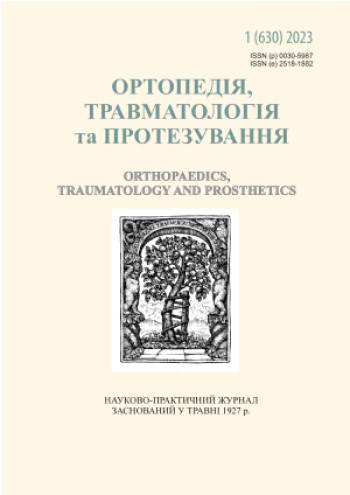WORK OF MUSCLES RESPONSIBLE FOR THE FUNCTIONING OF THE FOOT IN CONDITIONS OF KNEE JOINT CONTRACTURE
DOI:
https://doi.org/10.15674/0030-59872023149-54Keywords:
Knee joint, contracture, modeling, muscle strengthAbstract
Prolonged walking with knee joint contracture causes changes in the functioning of the muscles of the lower leg and foot. Objective. To study the functioning of the foot and leg muscles in the conditions of knee joint contracture using a human walking model. Methods. The gait analysis was performed in the OpenSim 4.0 program. The modeling was based on the gait2394 model. The following muscles were studied: m. peroneus brevis, m. peroneus longus, m. peroneus tertius, m. tibialis posterior, m. tibialis anterium, m. flexor digitorum longus, m. flexor hallucis longus, m. extensor digitorum longus, m. extensor hallucis longus. Results. Restriction of joint mobility leads to a redistribution of muscle strength. In conditions of 15° knee joint flexion contracture, support on the toes causes significant overstrain of the muscles responsible for the functioning of the lower leg, foot and toes. In particular, the m. peroneus brevis and m. peroneus longus are quite long, their function is impaired, but the required increase in strength is from 10 to 400 %, while the m. peroneus tertius (short), for foot flexion in some phases of the step, its strength increased threefold. Among the muscles of the lower leg, the greatest increase in isometric strength was required for the m. tibialis anterior compared to the m. tibialis posterior, which works mainly for foot extension. For the muscles responsible for flexion/extension of the toes in conditions of knee joint contracture, a significant, sometimes 3–5 times, increase in strength was necessary to perform the required function. Conclusions. Knee joint contracture leads to a change in the biomechanics of the entire lower extremity, namely, to an increase in changes in the functioning of the muscles responsible for the functioning of the foot, which work under such conditions with a constant increase in tension. Given the impact of knee joint contracture on the functioning of the muscles of the lower extremity, it is possible to predict the course of the
pathological process, determine which muscle groups are most affected and which muscle group needs to be corrected before and after surgery.
References
- Rico Licona, C. (2007). Incidencia de padecimientos ortopédicos en pacientes adultos atendidos en un Hospital de asistencia privada [Prevalence of orthopedic conditions in adult patients seen at a private hospital]. Acta ortopedica mexicana, (4), 177‒181. (in Spanish)
- Fishchenko, V. O., Saleh, O. K. J., & Karpinska, O. D. (2022). . Biomechanical justification of rehabilita¬tion measures after total knee replacement. TRAUMA, 23(1), 66–71. https://doi.org/10.22141/1608-1706.1.23.2022.884 (in Ukrainian)
- Anderson, F. C., & Pandy, M. G. (2001). Dynamic Optimization of Human Walking. Journal of Biomechanical Engineering, 123(5), 381–390. https://doi.org/10.1115/1.1392310
- Delp, S. L., Anderson, F. C., Arnold, A. S., Loan, P., Habib, A., John, C. T., Guendelman, E., & Thelen, D. G. (2007). OpenSim: Open-Source Software to Create and Analyze Dynamic Simulations of Movement. IEEE Transactions on Biomedical Engineering, 54(11), 1940–1950. https://doi.org/10.1109/tbme.2007.901024.
- Delp, S. L., Loan, J. P., Hoy, M. G., Zajac, F. E., Topp, E. L., & Rosen, J. M. (1990). An interactive graphics-based model of the lower extremity to study orthopaedic surgical procedures. IEEE Transactions on Biomedical Engineering, 37(8), 757–767. https://doi.org/10.1109/10.102791
- Loudon, J. K. (2008). The clinical orthopedic assessment guide (2th ed.). Kansas : Human Kinetics.
- Moore, K. L. (2010). Clinically oriented anatomy (6th ed). Philadelphia : Wolters Kluwer/Lippincott Williams & Wilkins.
- Yammine, K., & Erić, M. (2017). The Fibularis (Peroneus) Tertius Muscle in Humans: A Meta-Analysis of Anatomical Studies with Clinical and Evolutionary Implications. BioMed Research International, 2017, 1–12. https://doi.org/10.1155/2017/6021707
- Olewnik, Ł. (2019). Fibularis Tertius: Anatomical Study and Review of the Literature. Clinical Anatomy, 32(8), 1082–1093. https://doi.org/10.1002/ca.23449
- Palastanga, N. (2012). Anatomy and human movement: Structure and function (6th ed.). London, United Kingdom : Churchill Livingstone.
- Harato, K., Nagura, T., Matsumoto, H., Otani, T., Toyama, Y., & Suda, Y. (2008). A gait analysis of simulated knee flexion contracture to elucidate knee-spine syndrome. Gait & Posture, 28(4), 687–692. https://doi.org/10.1016/j.gaitpost.2008.05.008
Downloads
How to Cite
Issue
Section
License

This work is licensed under a Creative Commons Attribution 4.0 International License.
The authors retain the right of authorship of their manuscript and pass the journal the right of the first publication of this article, which automatically become available from the date of publication under the terms of Creative Commons Attribution License, which allows others to freely distribute the published manuscript with mandatory linking to authors of the original research and the first publication of this one in this journal.
Authors have the right to enter into a separate supplemental agreement on the additional non-exclusive distribution of manuscript in the form in which it was published by the journal (i.e. to put work in electronic storage of an institution or publish as a part of the book) while maintaining the reference to the first publication of the manuscript in this journal.
The editorial policy of the journal allows authors and encourages manuscript accommodation online (i.e. in storage of an institution or on the personal websites) as before submission of the manuscript to the editorial office, and during its editorial processing because it contributes to productive scientific discussion and positively affects the efficiency and dynamics of the published manuscript citation (see The Effect of Open Access).














